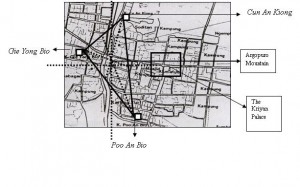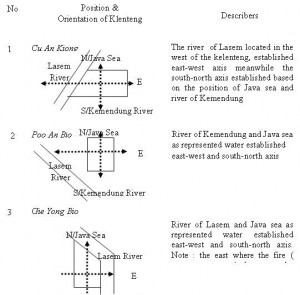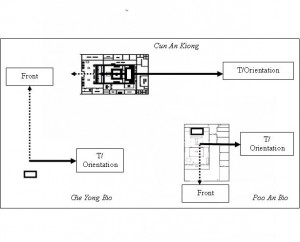IMPLEMENTATION OF THE CONCEPT OF BALANCE AT KELENTENG/SHRINE IN LASEM
T. Yoyok Wahyu Subroto ; Dyah S. Pradnya.P ; Afifah Harisah Hussein;
Department of Architecture and Planning, Gadjah Mada University
Jalan Grafika 2, Kampus UGM, Yogyakarta 55281, INDONESIA; archugm@indosat.net.id
Abstract
This research aims to explore and to identify all about the kelenteng (shrine) of Cu An Kiong, Poo An Bio and Gie Yong Bio in Lasem, Central Java. Based on empirical study, it is known that Taoism, Confusianism, and Buddhism cannot be apart from their culture and life where kelenteng becomes the place for conducting ritual activities. A fixed orientation of four cardinal directions such as east, west, south and north together with five basic elements of Taoism: water, fire, wood, metal and earth were harmonizing to set the building of kelenteng. It was becoming the basic cosmological concept consideration where the kelentengs have to be set.
1. Introduction
Lasem represents the old coastal town in north Central-Java where its initial residents almost entirely ethnic Chinese who came from mainland China and the major occupation were merchants. It is located at about 60 kilometers east of Semarang. As similar to other Chinese town, Lasem owns some shrines (or kelenteng in local-word) where Chinese residents usually use it for ritual activities. These kelentengs crossed for centuries at least more than 400 years which those buildings relatively still similar to their initial archaic building shapes and setting. Hence it is possible to explore historical background of those kelentengs. Regarding the exploration and implementation of the spatial structure pattern of those kelentengs in Lasem as the aims of the study, it is noted that there are some basic reasons that can be related to the context in which they originated. By observing the setting of kelenteng to include its spatial organization will lead this study to see the concept and its implementation as well.
2. Historical Review of Kelenteng in Lasem
There are fascinated stories to describe Lasem as coastal Chinese town in Central- Java during more than 400 years. Within 15th AD Century, Lasem Kingdom was under Majapahit Kingdom where the people in Lasem have encountered two major cultural influences such as Hinduism and Buddhism whereas in between 15th –17th AD century Lasem was becoming one of kadipaten (regency) under Mataram Kingdom which rose to power in the early 16th century and kept control of almost the whole island of Java to include Lasem where Javanese culture become predominated. Meanwhile in between 17th- 20th AD century, Lasem was used by the Dutch and the Japanase colonial government to be the important place for shipyard in Java. Nevertheles, during lengthy time some parts of Chinese settlement in Lasem still survive which is represented by such three kelentengs as Cu An Kiong at Dasun, Poo An Bio at Karangturi and Gie Yong Bio at Babagan.
Talking about Chinese settlement in Lasem, it cannot be apart from their religion as Taoism, Confusianism, and Buddhism. These religions also cannot be apart from their culture and life where kelenteng becomes the place for conducting ritual activities. As mentioned above, in Lasem there are three kelenteng which have their own stories related to their construction. The kelenteng of Cu An Kiong was founded for respecting Tiang Shang Sheng Mu as a spirit of shipmen whereas kelenteng of Poo An Bio was founded for respecting Guo Zhong Fu as a spirit of overseas. Meanwhile the kelenteng of Gie Yong Bio was founded for respecting of three heroes namely Tian Pan Tjiang, Oei Ing Kiat and Raden Panji Margono (the Javanese) who have a spirit as a heroes of Lasem. It seems that all kelenteng were developed in order to rise up the spirit of life for the people of Lasem.
3. Religion of Chinese Focal Point in the Setting
As mentioned above, the original ancestors of the Chinese have three traditional main streams of religion such as Taoism, Confusianism, and Buddhism. Taoism has some sacred spaces and rules to present special ritual activity in related to bring the Taoism adherents relationship to the Gods closer. Meanwhile Confusianism have not own a sacred space to provide an opportunity for the adherents to take an interaction to their ancestors, whereas Buddhism have own a simple sacred space to provide an opportunity for the adherents to take an interaction to Sidharta Gautama. In summary, the Chinese in Lasem have prefered to accept, incorporate, absorb and integrate the influences of those religions to be applied into their livelihood.
4. Discussions
4.1.The Setting of Three Kelenteng in Lasem
From the aerial view, it is noted that the three kelentengs of Cu An Kiong, Poo An Bio and Gie Yong Bio were considerably a fixed orientation of four cardinal directions such as east, west, south and north. These cardinal directions then become one basic order to set the kelenteng. On the other hand according to the such indigenous Taoism as the five basic elements : water, fire, wood, metal and earth also become the other basic cosmological concept consideration which play an important role in setting the kelenteng. In macrocosmos point of view seems that the two former basic elements of Taoism as water and fire are clearly be implemented in the setting of kelenteng in Lasem syncronizing with the cardinal direction of south-north and east-west. The water that comes from the rivers which empties into the sea in the north where the sea of Java is located symbolizing the water. It establishes the cardinal axis direction of south-north.. Meanwhile the mount of Puro (Argopuro) in the east (which also constitutes the point where the sun arises) symbolized the fire which is provided by the intense volcanic activity establish the cardinal axis direction of east-west (see Figure 1)
Figure 1: Setting of the Three Kelenteng in Lasem and the Kriyan Palace
Source : Survey, 2004
4.2. The Orientation of the Three Kelentengs in Lasem
Exploration of the orientation and position of the three kelenteng in mess-level indicated that there is a consistency of the consideration of fixed orientation of four cardinal directions such as east, west, south and north to include the five basic elements of Taoism. Data in Table 1 indicated that the east direction as in Lasem represented of orientation to fire (mount or sun) is implemented. On the other side, water seems to be dependent element which makes the kelenteng faces to it. Even though the water where in mezzo level is represented by the river of Lasem are located different from place to place of kelenteng, there is an order of position to which the cardinal points of south, north, east or west constitutes the only right direction to be faced by the kelenteng.
Table 1. The Implementation of Cardinal Direction Axis in the Setting of Kelenteng in Lasem
5
4.3. The Micro Spatial of Lasem
In the micro spatial level of Lasem which is represented by the building of kelenteng, it was found that a fixed orientation of four cardinal directions such as east, west, south and north, was implemented. Figure 2 represents that the front of all kelentengs which refer to the orientation of kelenteng have a dissimilar orientation of the main altar where the ancestor-statues exist. It is directed to the east symbolizing the orientation of fire which is aimed to gain safety of Chinese inhabitants. Accordingly the axial line of west-east and south-north are implemented symbolizing the concept of balance to gain harmonization of the livelihood. This condition could describe as :
5.Conclusion
It is concluded that the axial line which represents the four cardinal directions is directed to harmonize nature and it is to be used for guiding the setting of kelenteng in Lasem. The axial lines are also established based on the Taoism concept which consist the five basic elements: water, fire, wood, metal and earth which is synchronized with four cardinal points such as east, west, south and north. The Taoism concept constitutes the basic cosmological concept consideration which plays an important role in setting the kelenteng.
References
Santi, Badra dalam Pratiwo. 1990. The Architecture of Lasem : Typo-Morphological
Approach for Redefining Chinese Architecture, Urban & Renewal Planning Human Settlement, Department of Architecture Urban & Regional Planning. University of Leuven, Belgium
Hutama, David.1999. Lasem is a town forgotten, a case study about changing of image in a Northen Coustal Town of Java, Journal Tatanan Volume I, July I.
Pratiwo, 1990. The Architecture of Lasem : Typo-Morphological Approach for Redefining Chinese Architecture, Urban & Renewal Planning Human Settlement, Department of Architecture Urban & Regional Planning. University of Leuven, Belgium.
Yayasan Trimurti. 2001. Klenteng Poo An Bio Lasem Dan Kongco Kong Tik Cun Ong
———————-2001. Tian Shang Sheng Mu, Totelary of Shipmen
——————— 2001. History of Kelenteng Babagan in Lasem
Yun , Lin. 2000.Design Interior with Tibet Feng Shui, Harmony
[1] Paper presented at the International Seminar on Culture of Living organized by Technische Universitat Wien, Austria and Dept. of Architecture and Planning, Faculty of Engineering, Gadjah Mada University on Feb. 19, 2005
[1] Lecturer, Department of Architecture and Planning, Faculty of Engineering, Gadjah Mada University.
[1].4 Graduate student,Department of Architecture and Planning,Faculty of Engineering,Gadjah Mada University


